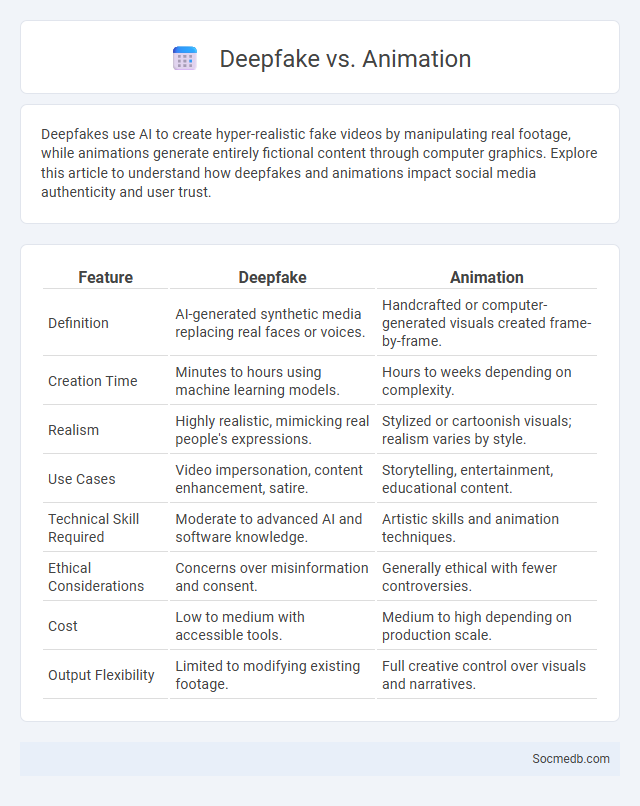
Photo illustration: Deepfake vs Animation
Deepfakes use AI to create hyper-realistic fake videos by manipulating real footage, while animations generate entirely fictional content through computer graphics. Explore this article to understand how deepfakes and animations impact social media authenticity and user trust.
Table of Comparison
| Feature | Deepfake | Animation |
|---|---|---|
| Definition | AI-generated synthetic media replacing real faces or voices. | Handcrafted or computer-generated visuals created frame-by-frame. |
| Creation Time | Minutes to hours using machine learning models. | Hours to weeks depending on complexity. |
| Realism | Highly realistic, mimicking real people's expressions. | Stylized or cartoonish visuals; realism varies by style. |
| Use Cases | Video impersonation, content enhancement, satire. | Storytelling, entertainment, educational content. |
| Technical Skill Required | Moderate to advanced AI and software knowledge. | Artistic skills and animation techniques. |
| Ethical Considerations | Concerns over misinformation and consent. | Generally ethical with fewer controversies. |
| Cost | Low to medium with accessible tools. | Medium to high depending on production scale. |
| Output Flexibility | Limited to modifying existing footage. | Full creative control over visuals and narratives. |
Understanding Deepfake Technology
Deepfake technology uses artificial intelligence to create highly realistic but fake videos and images by manipulating facial features and voices, posing significant risks to social media authenticity. Understanding deepfake algorithms helps you recognize manipulated content and protect your digital identity from misinformation or fraud. Social media platforms are increasingly implementing advanced detection tools to identify and remove deepfake media, safeguarding users' trust and online security.
What is Animation?
Animation is the process of creating motion and shape change illusion by displaying a sequence of images or frames in rapid succession. It combines techniques such as 2D and 3D modeling, computer-generated imagery (CGI), and stop-motion to produce dynamic visual content widely used in social media marketing, entertainment, and educational platforms. Advanced animation software like Adobe After Effects and Blender enables creators to produce engaging and shareable content that enhances user interaction and brand visibility.
Deepfake vs Animation: Defining the Differences
Deepfake technology uses artificial intelligence to create highly realistic but fabricated videos or images that manipulate an actual person's likeness, while animation involves crafting content through illustrated or computer-generated visuals without impersonating real individuals. Your understanding of these distinctions enhances awareness of content authenticity and potential misuses on social media platforms. Recognizing deepfakes' potential for misinformation contrasts with animation's role in creative storytelling and digital artistry.
How Deepfake Works: AI and Machine Learning
Deepfake technology uses AI algorithms, particularly deep learning and neural networks, to manipulate and generate realistic images, audio, or video content that mimics real individuals. Machine learning models, such as Generative Adversarial Networks (GANs), train on large datasets of facial expressions, voice patterns, and movements, enabling the creation of synthetic media that can be difficult to distinguish from authentic recordings. This technology poses significant challenges for social media platforms in detecting and mitigating misinformation and maintaining content authenticity.
Animation Techniques: Traditional vs Digital
Traditional animation techniques rely on hand-drawn frames and physical mediums such as cels and paper, creating a tactile and artisanal quality that appeals to nostalgic audiences. Digital animation utilizes software like Adobe Animate, Blender, or Toon Boom Harmony, enabling faster production, complex effects, and seamless integration with 3D modeling for modern social media content. Brands leveraging digital animation techniques often see increased engagement on platforms like Instagram and TikTok due to dynamic visuals and scalable formats optimized for mobile viewing.
Applications of Deepfake in Media
Deepfake technology enables the creation of hyper-realistic synthetic videos and images, transforming social media content by enhancing entertainment, marketing, and political campaigns. Media companies use deepfakes for personalized advertisements, virtual influencers, and resurrecting historical figures in documentaries. Despite its innovative applications, the rise of deepfake media necessitates advanced detection tools to combat misinformation and protect digital trust.
Animation in Entertainment and Beyond
Animation in social media transforms entertainment by creating engaging visual stories that captivate Your audience and increase interaction. Platforms like Instagram, TikTok, and YouTube leverage animated content to enhance marketing campaigns, educational videos, and brand storytelling. This dynamic use of animation extends beyond entertainment, driving innovation in advertising, virtual events, and digital communication strategies.
Ethical Concerns: Deepfake vs Animation
Deepfake technology raises significant ethical concerns due to its potential to manipulate social media content, misleading viewers by creating hyper-realistic but fake videos that can harm reputations and spread disinformation. Unlike traditional animation, which is understood as creative storytelling, deepfakes blur the line between reality and fabrication, posing risks to privacy and trust in digital media. Your awareness of these distinctions is crucial for critically evaluating content and protecting the integrity of online information.
Realism and Visual Believability Compared
Realism and visual believability on social media platforms significantly influence user engagement and content credibility. High-quality graphics, authentic imagery, and realistic video effects foster trust and emotional connection, enhancing the overall user experience. Advances in AI-generated content have blurred the lines between real and fabricated visuals, prompting platforms to prioritize transparency and verification tools.
The Future of Digital Content Creation
The future of digital content creation is shaped by emerging technologies like AI-driven tools, immersive AR/VR experiences, and real-time interactive platforms that enable creators to produce personalized and engaging content. Social media algorithms increasingly prioritize authentic, diverse, and multimedia-rich posts, pushing creators to adapt strategies for higher audience retention and growth. Data analytics and influencer marketing continue to evolve, providing deeper insights and more targeted collaborations that drive monetization and brand engagement in dynamic digital ecosystems.
 socmedb.com
socmedb.com